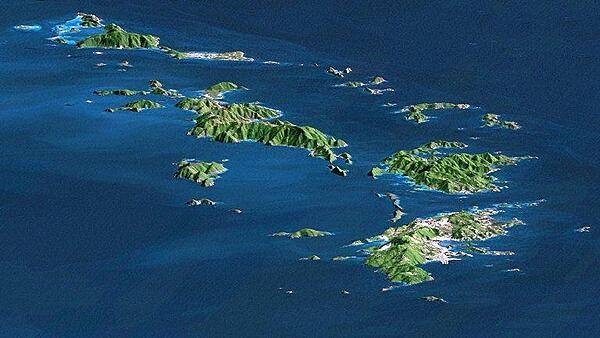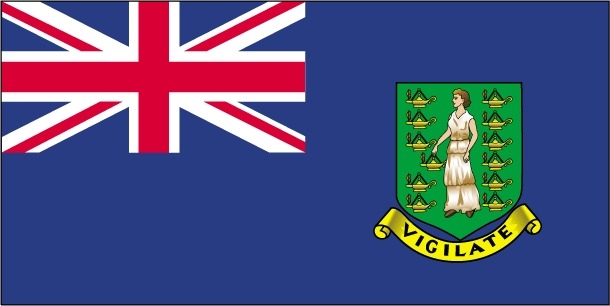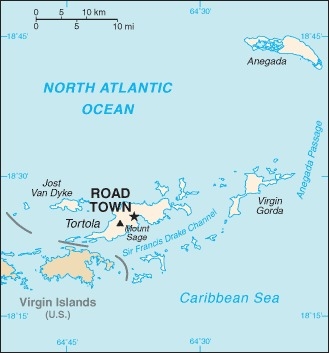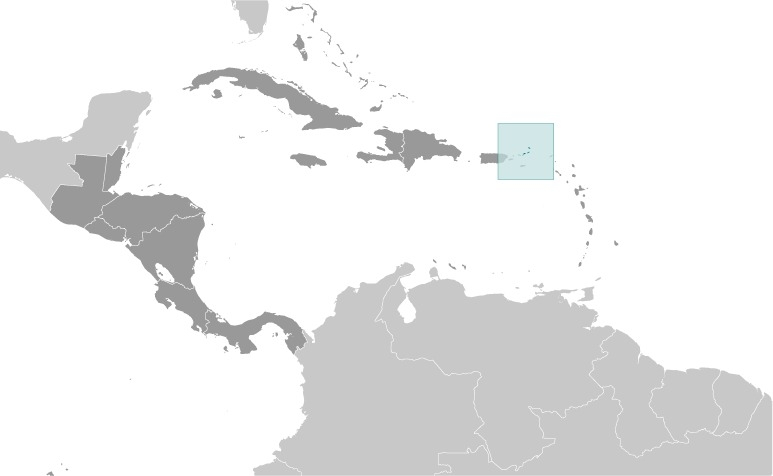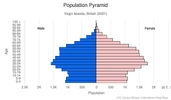British Virgin Islands
Introduction
Background
First inhabited by Arawak and later by Carib Indians, the Virgin Islands were settled by the Dutch in 1648 and then annexed by the English in 1672. The islands were part of the British colony of the Leeward Islands from 1872-1960; they were granted autonomy in 1967. The economy is closely tied to the larger and more populous US Virgin Islands to the west; the US dollar is the legal currency. On 6 September 2017, Hurricane Irma devastated the island of Tortola. An estimated 80% of residential and business structures were destroyed or damaged, communications disrupted, and local roads rendered impassable.
Visit the Definitions and Notes page to view a description of each topic.
Geography
Location
Caribbean, between the Caribbean Sea and the North Atlantic Ocean, east of Puerto Rico
Geographic coordinates
18 30 N, 64 30 W
Map references
Central America and the Caribbean
Area
total: 151 sq km
land: 151 sq km
water: 0 sq km
note: comprised of 16 inhabited and more than 20 uninhabited islands; includes the islands of Tortola, Anegada, Virgin Gorda, Jost van Dyke
Area - comparative
about 0.9 times the size of Washington, DC
Land boundaries
total: 0 km
Coastline
80 km
Maritime claims
territorial sea: 12 nm
exclusive fishing zone: 200 nm
Climate
subtropical; humid; temperatures moderated by trade winds
Terrain
coral islands relatively flat; volcanic islands steep, hilly
Elevation
highest point: Mount Sage 521 m
lowest point: Caribbean Sea 0 m
Natural resources
NEGL; pleasant climate, beaches foster tourism
Land use
agricultural land: 46.7% (2018 est.)
arable land: 6.7% (2018 est.)
permanent crops: 6.7% (2018 est.)
permanent pasture: 33.3% (2018 est.)
forest: 24.3% (2018 est.)
other: 29% (2018 est.)
Population distribution
a fairly even distribution throughout the inhabited islands, with the largest islands of Tortola, Anegada, Virgin Gorda, and Jost Van Dyke having the largest populations
Natural hazards
hurricanes and tropical storms (July to October)
Geography - note
strong ties to nearby US Virgin Islands and Puerto Rico
People and Society
Nationality
noun: British Virgin Islander(s)
adjective: British Virgin Islander
Ethnic groups
African/Black 76.3%, Latino 5.5%, White 5.4%, mixed 5.3%, Indian 2.1%, East Indian 1.6%, other 3%, unspecified 0.8% (2010 est.)
Languages
English (official)
Religions
Protestant 70.2% (Methodist 17.6%, Church of God 10.4%, Anglican 9.5%, Seventh Day Adventist 9.0%, Pentecostal 8.2%, Baptist 7.4%, New Testament Church of God 6.9%, other Protestant 1.2%), Roman Catholic 8.9%, Jehovah's Witness 2.5%, Hindu 1.9%, other 6.2%, none 7.9%, unspecified 2.4% (2010 est.)
Age structure
0-14 years: 16.48% (male 3,088/female 3,156)
15-24 years: 12.22% (male 2,212/female 2,418)
25-54 years: 47.84% (male 8,476/female 9,652)
55-64 years: 12.83% (male 2,242/female 2,521)
65 years and over: 10.63% (male 1,921/female 2,105) (2021 est.)
Dependency ratios
total dependency ratio: NA
youth dependency ratio: NA
elderly dependency ratio: NA
potential support ratio: NA
Median age
total: 37.2 years
male: 37 years
female: 37.5 years (2020 est.)
Population distribution
a fairly even distribution throughout the inhabited islands, with the largest islands of Tortola, Anegada, Virgin Gorda, and Jost Van Dyke having the largest populations
Urbanization
urban population: 48.9% of total population (2021)
rate of urbanization: 1.73% annual rate of change (2020-25 est.)
Major urban areas - population
15,000 ROAD TOWN (capital) (2018)
Sex ratio
at birth: 1.05 male(s)/female
0-14 years: 0.97 male(s)/female
15-24 years: 0.92 male(s)/female
25-54 years: 0.88 male(s)/female
55-64 years: 0.94 male(s)/female
65 years and over: 0.92 male(s)/female
total population: 0.91 male(s)/female (2020 est.)
Infant mortality rate
total: 14.56 deaths/1,000 live births
male: 17.39 deaths/1,000 live births
female: 11.58 deaths/1,000 live births (2021 est.)
Life expectancy at birth
total population: 79.44 years
male: 77.94 years
female: 81.03 years (2021 est.)
Drinking water source
improved: total: 100% of population
unimproved: total: 0% of population (2017 est.)
Sanitation facility access
improved: urban: 97.5% of population
rural: 97.5% of population
total: 97.5% of population
unimproved: urban: 2.5% of population
rural: 2.5% of population
total: 2.5% of population (2015 est.)
School life expectancy (primary to tertiary education)
total: 12 years
male: 12 years
female: 12 years (2018)
Environment
Environment - current issues
limited natural freshwater resources except for a few seasonal streams and springs on Tortola; most of the islands' water supply comes from desalination plants; sewage and mining/industry waste contribute to water pollution, threatening coral reefs
Air pollutants
carbon dioxide emissions: 0.21 megatons (2016 est.)
Climate
subtropical; humid; temperatures moderated by trade winds
Land use
agricultural land: 46.7% (2018 est.)
arable land: 6.7% (2018 est.)
permanent crops: 6.7% (2018 est.)
permanent pasture: 33.3% (2018 est.)
forest: 24.3% (2018 est.)
other: 29% (2018 est.)
Urbanization
urban population: 48.9% of total population (2021)
rate of urbanization: 1.73% annual rate of change (2020-25 est.)
Waste and recycling
municipal solid waste generated annually: 21,099 tons (2000 est.)
Government
Country name
conventional long form: none
conventional short form: British Virgin Islands
abbreviation: BVI
etymology: the myriad islets, cays, and rocks surrounding the major islands reminded explorer Christopher COLUMBUS in 1493 of Saint Ursula and her 11,000 virgin followers (Santa Ursula y las Once Mil Virgenes), which over time shortened to the Virgins (las Virgenes)
Government type
Overseas Territory of the UK with limited self-government; parliamentary democracy
Dependency status
Overseas Territory of the UK; internal self-governing
Capital
name: Road Town
geographic coordinates: 18 25 N, 64 37 W
time difference: UTC-4 (1 hour ahead of Washington, DC, during Standard Time)
etymology: name refers to the nautical term "roadstead" or "roads," a body of water less sheltered than a harbor but where where ships can lie reasonably safely at anchor sheltered from rip currents, spring tides, or ocean swells
Administrative divisions
none (overseas territory of the UK)
Independence
none (Overseas Territory of the UK)
National holiday
Territory Day, 1 July (1956)
Constitution
history: several previous; latest effective 15 June 2007 (The Virgin Islands Constitution Order 2007)
amendments: initiated by any elected member of the House of Assembly; passage requires simple majority vote by the elected members of the Assembly and assent by the governor on behalf of the monarch; amended 2015
Legal system
English common law
Citizenship
see United Kingdom
Suffrage
18 years of age; universal
Executive branch
chief of state: Queen ELIZABETH II (since 6 February 1952); represented by Governor John J. RANKIN (since 29 January 2021)
head of government: Premier Andrew FAHIE (since 26 February 2019)
cabinet: Executive Council appointed by the governor from members of the House of Assembly
elections/appointments: the monarchy is hereditary; governor appointed by the monarch; following legislative elections, the leader of the majority party or majority coalition usually appointed premier by the governor
Legislative branch
description: unicameral House of Assembly (15 seats; 13 members - 9 in single-seat constituencies and 4 at-large seats directly elected by simple majority vote and 2 ex-officio members - the attorney general and the speaker - chosen from outside the House; members serve 4-year terms)
elections: last held on 25 February 2019 (next to be held in 2023)
election results: percent of vote by party - VIP 46.5%, NDP 28.2%, PVIM 17.4%, PU 8%; seats by party - VIP 8, NDP 3, PVIM 1, PU 1; composition - men 12, women 3, percent of women 20%
Judicial branch
highest courts: the Eastern Caribbean Supreme Court (ECSC) is the superior court of the Organization of Eastern Caribbean States; the ECSC - headquartered on St. Lucia - consists of the Court of Appeal - headed by the chief justice and 4 judges - and the High Court with 18 judges; the Court of Appeal is itinerant, traveling to member states on a schedule to hear appeals from the High Court and subordinate courts; High Court judges reside in the member states, with 3 in the British Virgin Islands
judge selection and term of office: Eastern Caribbean Supreme Court chief justice appointed by Her Majesty, Queen ELIZABETH II; other justices and judges appointed by the Judicial and Legal Services Commission; Court of Appeal justices appointed for life with mandatory retirement at age 65; High Court judges appointed for life with mandatory retirement at age 62
subordinate courts: Magistrates' Courts
Political parties and leaders
National Democratic Party or NDP [Myron WALWYN]
People's Empowerment Party or PEP [Alvin CHRISTOPHER]
Progressive Virgin Islands Movement or PVIM [Ronnie SKELTON]
Progressives United or PU [Julian FRASER]
Virgin Islands Party or VIP [Andrew FAHIE]
International organization participation
Caricom (associate), CDB, Interpol (subbureau), IOC, OECS, UNESCO (associate), UPU
Diplomatic representation in the US
none (overseas territory of the UK)
Diplomatic representation from the US
embassy: none (overseas territory of the UK)
Flag description
blue with the flag of the UK in the upper hoist-side quadrant and the Virgin Islander coat of arms centered in the outer half of the flag; the coat of arms depicts a woman flanked on either side by a vertical column of six oil lamps above a scroll bearing the Latin word VIGILATE (Be Watchful); the islands were named by COLUMBUS in 1493 in honor of Saint Ursula and her 11 virgin followers (some sources say 11,000) who reputedly were martyred by the Huns in the 4th or 5th century; the figure on the banner holding a lamp represents the saint; the other lamps symbolize her followers
National symbol(s)
zenaida dove, white cedar flower; national colors: yellow, green, red, white, blue
National anthem
note: as a territory of the United Kingdom, "God Save the Queen" is official (see United Kingdom)
Economy
Economic overview
The economy, one of the most stable and prosperous in the Caribbean, is highly dependent on tourism, which generates an estimated 45% of the national income. More than 934,000 tourists, mainly from the US, visited the islands in 2008. Because of traditionally close links with the US Virgin Islands, the British Virgin Islands has used the US dollar as its currency since 1959.
Livestock raising is the most important agricultural activity; poor soils limit the islands' ability to meet domestic food requirements.
In the mid-1980s, the government began offering offshore registration to companies wishing to incorporate in the islands, and incorporation fees now generate substantial revenues. Roughly 400,000 companies were on the offshore registry by yearend 2000. The adoption of a comprehensive insurance law in late 1994, which provides a blanket of confidentiality with regulated statutory gateways for investigation of criminal offenses, made the British Virgin Islands even more attractive to international business.
Real GDP (purchasing power parity)
$500 million (2017 est.)
$490.2 million (2016 est.)
$481.1 million (2015 est.)
Real GDP growth rate
2% (2017 est.)
1.9% (2016 est.)
1.8% (2015 est.)
GDP (official exchange rate)
$1.028 billion (2017 est.)
GDP - composition, by sector of origin
agriculture: 0.2% (2017 est.)
industry: 6.8% (2017 est.)
services: 93.1% (2017 est.)
GDP - composition, by end use
household consumption: 25.1% (2017 est.)
government consumption: 7.5% (2017 est.)
investment in fixed capital: 21.7% (2017 est.)
investment in inventories: 20.4% (2017 est.)
exports of goods and services: 94.7% (2017 est.)
imports of goods and services: -69.4% (2017 est.)
Agricultural products
fruits, vegetables; livestock, poultry; fish
Industries
tourism, light industry, construction, rum, concrete block, offshore banking center
Labor force - by occupation
agriculture: 0.6%
industry: 40%
services: 59.4% (2005)
Household income or consumption by percentage share
lowest 10%: NA
highest 10%: NA
Budget
revenues: 400 million (2017 est.)
expenditures: 400 million (2017 est.)
Fiscal year
1 April - 31 March
Current account balance
$362.6 million (2011 est.)
$279.8 million (2010 est.)
Exports - partners
Malta 30%, Seychelles 29%, Switzerland 14% (2019)
Exports - commodities
recreational boats, aircraft, diamonds, paintings, precious stones (2019)
Imports - partners
Germany 32%, United States 22%%, Italy 9%, France 7%, Seychelles 7% (2019)
Imports - commodities
recreational boats, aircraft, refined petroleum, cars, furniture (2019)
Exchange rates
the US dollar is used
Energy
Electricity access
electrification - total population: 100% (2020)
Electricity - installed generating capacity
45,200 kW (2016 est.)
country comparison to the world: 192Electricity - from fossil fuels
97% of total installed capacity (2016 est.)
country comparison to the world: 33Electricity - from nuclear fuels
0% of total installed capacity (2017 est.)
country comparison to the world: 55Electricity - from hydroelectric plants
0% of total installed capacity (2017 est.)
country comparison to the world: 160Electricity - from other renewable sources
3% of total installed capacity (2017 est.)
country comparison to the world: 121Refined petroleum products - consumption
20,000 bbl/day (2016 est.)
country comparison to the world: 141Communications
Telephones - fixed lines
total subscriptions: 7,311 (2019)
subscriptions per 100 inhabitants: 24.35 (2019 est.)
Telephones - mobile cellular
total subscriptions: 35,163 (2020)
subscriptions per 100 inhabitants: 116.3 (2020 est.)
Telecommunication systems
general assessment: good overall telephone service; major expansion sectors include the mobile telephony and data segments, which continue to appeal to operator investment; several operators licensed to provide services within individual markets, most of them are small and localized; telecommunication contributes to overall GDP (2020)
domestic: fixed-line connections exceed 21 per 100 persons and mobile cellular subscribership is roughly 198 per 100 persons (2019)
international: country code - 1-284; landing points for PCCS, ECFS, CBUS, Deep Blue Cable, East-West, PAN-AM, Americas-1, Southern Caribbean Fiber, Columbus- IIb, St Thomas - St Croix System, Taino-Carib, and Americas I- North via submarine cable to Caribbean, Central and South America, and US (2019)
note: the COVID-19 pandemic continues to have a significant impact on production and supply chains globally; since 2020, some aspects of the telecom sector have experienced downturn, particularly in mobile device production; many network operators delayed upgrades to infrastructure; progress towards 5G implementation was postponed or slowed in some countries; consumer spending on telecom services and devices was affected by large-scale job losses and the consequent restriction on disposable incomes; the crucial nature of telecom services as a tool for work and school from home became evident, and received some support from governments
Broadcast media
1 private TV station; multi-channel TV is available from cable and satellite subscription services; about a half-dozen private radio stations
Internet users
total: 23,600 (2021 est.)
percent of population: 77.7% (2019 est.)
Broadband - fixed subscriptions
total: 6,738 (2020)
subscriptions per 100 inhabitants: 22.29 (2020 est.)
Transportation
Airports - with paved runways
total: 2
914 to 1,523 m: 1
under 914 m: 1 (2019)
Airports - with unpaved runways
total: 2
914 to 1,523 m: 2 (2013)
Merchant marine
total: 30
by type: general cargo 3, other 27 (2021)
Ports and terminals
major seaport(s): Road Harbor
Military and Security
Military - note
defense is the responsibility of the UK
Transnational Issues
Illicit drugs
transshipment point for South American narcotics destined for the US and Europe; large offshore financial center makes it vulnerable to money laundering
